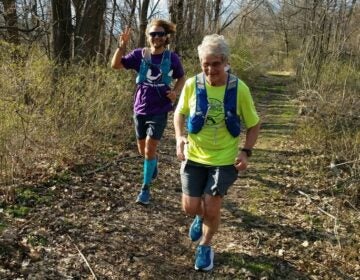Burlington County program puts teens in the shoes of police
ListenBurlington County officials are hoping to change teens’ perspectives on law enforcement with an evening of police videos, plastic guns, and pizza.
The Police and Teens Together, or PATT, brings together nearby middle- and high-schoolers and officers from the Burlington County sheriff’s office for an informational program on law enforcement.
PATT began in September, amid a national conversation on policing, in an effort to combat growing distrust of law enforcement, said Sheriff Jean Stanfield.
“It’s what’s being put on the media, what the kids are seeing, whether it’s YouTube or other things, emphasizing some of the negative sides of law enforcement,” said Stanfield. “We want them to see that, hey, there’s two sides to every story.”
Organizers recruit teenagers from schools, community organizations, and faith-based groups. So far about 55 children have gone through PATT.
One of them, 17-year-old Willingboro resident Carlos Davila, said the program made him think twice about how police officers conduct a stop.
“I see now, like, some of the stuff that they do is for a reason,” he said. “Their side of the story and the other person’s side of the story — you never really know both sides until you look into it.”
On a recent Wednesday, Davila and four other teenagers were role-playing a traffic stop with detective Mike Lynch of the sheriff’s office.
Lynch played the role of an agitated driver, while Davila acted as the cop who pulled him over:
“What do you want? What are you stopping me for?”
“Sir, could you please roll down your window?”
“Why are you stopping me? I wanna know why you’re stopping me.”
“I can’t communicate with you — “
“Why can’t you? You’re communicating with me right now. All right, here, I’ll put it down a little bit. What are you stopping me for?”
Moments later Davila shook his head and smiled. He said it was understandable that police keep their guard up during stops, an attitude that could come off as standoffish rather than cautious to civilians.
“You never know where people could come from if it’s a dangerous situation. You got a lot of on-the-spot decisions that you have to make,” said Davila. “It’s really hard. I was struggling.”
During another part of the event, officers showed the teenagers a video of an actual traffic stop that turned deadly. As an officer begins to pat down a driver who had been cooperating, the driver pulls out a gun and shoots the officer several times, killing him.
“What was your gut feeling?” said detective Mike Vining. “What did you see?”
“I just think it all could have been avoided if he had told the truth, [if he] had said ‘I have a gun,'” said one girl. “Because killing somebody just isn’t worth it.”
Amy Dean, executive director of Faith in Action, the nonprofit partner of PATT, said the program allows cops and teens to understand each other and challenge their stereotypes.
“Now [the teenagers] are realizing that these police officers are human. They have families. They have feelings,” said Dean. “The police officers are also getting a different perception of young people, because they actually have meaningful thoughts and ideas as well.”
Should the officers and teens interact in the future, Dean said, PATT will have given them the personal history to make it a positive meeting rather than a tense one.
“Some of the officers will see some of the students at school or on the streets, and they can actually speak to them and say ‘Hey officer so-and-so,’ and there’s a smile. Whoa! A serious exchange!” said Dean. “Whereas usually kids would go ‘Ugh, the police’ and they’ll run or they’ll just go away or roll their eyes or stick the middle finger up.”
During the second night of the two-day program, teenagers will use the county’s Firearms Automated Training System (F.A.T.S), which simulates scenarios that could require officers to shoot suspects.
Stanfield said she hopes to partner with individual police departments next year in order to make the program available to more children closer to where they live.
WHYY is your source for fact-based, in-depth journalism and information. As a nonprofit organization, we rely on financial support from readers like you. Please give today.











